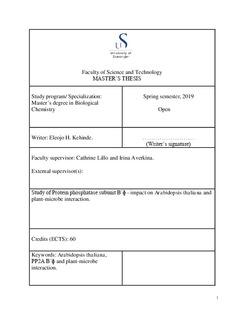| dc.contributor.advisor | Lillo, Cathrine | |
| dc.contributor.author | Kehinde, Eleojo | |
| dc.date.accessioned | 2019-10-22T12:57:53Z | |
| dc.date.available | 2019-10-22T12:57:53Z | |
| dc.date.issued | 2019-06-14 | |
| dc.identifier.uri | http://hdl.handle.net/11250/2623757 | |
| dc.description | Master's thesis in Biological chemistry | nb_NO |
| dc.description.abstract | The protein phosphatase 2A (PP2A) complex accounts for a considerable part of the protein dephosphorylation. PP2A is made up of three types of subunits, a catalytic(C), scaffolding (A) and regulatory (B) subunit. A certain subgroup of B’ called B’ɸ(B’phi) clade appears to be essential for the interactions between plants and microorganism (especially mycorrhiza) and is the focus in this thesis. The B’phi gene is not present in the model plant A. thaliana. The B’phi gene from Heinz tomato was isolated in our lab, cloned into a plasmid vector and transferred to A. thaliana. These plants are now to be further investigated in the master project.
The main objectives of this project are to check the expression of B’phi (RNA isolation with subsequent RT-PCR). Selection on Basta to check if the plants are homozygous for the insert. Effects of microbes like Pseudomonas will be tested. Stress conditions, salt, microbe-associated molecular patterns (chitin) and others are to be tested. Three mutants (B’phi 13, 16 and 20) used in this experiment were homozygous for the insert.
Flowering between Mutant and Wild type plants in two different sets of experiment only B’phi 13 was used showed faster flowering in Mutant plants than in the wild type plants.
Gene expression analysis was also carried out and the result of this experiment showed that the gene of insert B’phi is expressed. Gene sequencing showed a 100% match confirming that the gene B’phi is what has been used for all the analysis in this thesis.
Co-cultivation with Pseudomonas showed increase in chlorophyll in the Mutant plants (B’phi 13 and 16). For Salt stress, the Mutant plants (B’phi 13 and 16) had better survival response than the Wild type plants and had higher chlorophyll content than the Wild type plants except in B’phi 13 (1) and 16 (2) experiments where their chlorophyll content was low at concentrations 50 mM and 0 mM respectively. This might have occurred because of transplanting of poorly selected 1-week old seedlings to the salt medium. Chlorophyll is an important pigment for photosynthesis which is known to help in the growth and development of plants. Therefore, B’phi can bring about improvement in Agriculture especially because of its effect seen in this work, thereby reducing the challenge of food shortage. | nb_NO |
| dc.language.iso | eng | nb_NO |
| dc.publisher | University of Stavanger, Norway | nb_NO |
| dc.relation.ispartofseries | Masteroppgave/UIS-TN-IKBM/2019; | |
| dc.subject | Arabidopsis thaliana | nb_NO |
| dc.subject | PP2A B’ɸ and plant-microbe interaction. | nb_NO |
| dc.subject | biokjemi | nb_NO |
| dc.subject | biologisk kjemi | nb_NO |
| dc.subject | biochemistry | nb_NO |
| dc.title | Study of Protein phosphatase subunit B’ɸ - impact on Arabidopsis thaliana and plant-microbe interaction. | nb_NO |
| dc.type | Master thesis | nb_NO |
| dc.description.version | submittedVersion | nb_NO |
| dc.subject.nsi | VDP::Mathematics and natural science: 400::Basic biosciences: 470::Biochemistry: 476 | nb_NO |
